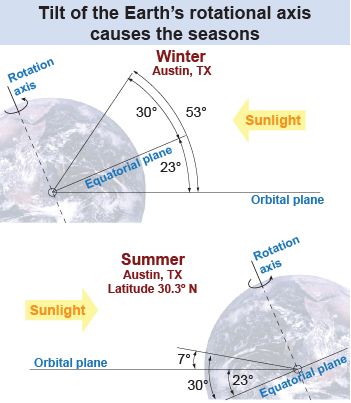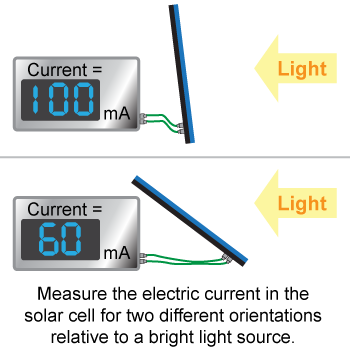|
To analyze something means to intellectually take it apart and study both the pieces and how the pieces fit together. Scientific analysis takes a complex phenomenon and breaks it down into understandable parts that can each be explained. Consider the fact of seasons. Any explanation for why there are seasons must account for empirical evidence and observations such as: - The day is longer in the summer and shorter in the winter;
- The average temperature is colder in winter than in summer; and
- In the northern hemisphere the Sun appears at a lower angle in the sky in winter and higher in summer.

|
 The explanation for seasons is that Earth’s rotational axis is tilted about 23 degrees relative to the plane of its orbit, which you will learn more about on page 380. Logically, how does this explanation account for the evidence? Consider the angle of the Sun in the sky. If the explanation is true then logically (mathematically) it follows that:
The explanation for seasons is that Earth’s rotational axis is tilted about 23 degrees relative to the plane of its orbit, which you will learn more about on page 380. Logically, how does this explanation account for the evidence? Consider the angle of the Sun in the sky. If the explanation is true then logically (mathematically) it follows that: - An observer in Austin, Texas (30°N latitude) should see the Sun 53° away from vertical at noon in winter; and
- The same observer should see the noon Sun 7° away from vertical in summer.
Observational evidence confirms that this is exactly the angle at which the Sun appears, therefore supporting the explanation. 
|

| How could the solar angle explain the seasonal temperature change? Consider the following experiment. A solar cell of a certain size is held at different angles to a bright light. The light energy received by the solar cell is measured by recording the electric current produced at each angle. The experiment finds that the solar cell receives 40% less energy at 53° compared to when it is at 7°. Thus, experimental testing also supports the explanation of a tilted axis by accounting for another observed effect. In fact, the tilted axis theory accounts for every single observation and experimental prediction that can be tested. While technically this explanation is called a theory it is so well tested that it is accepted as fact. |

|
| |
|

